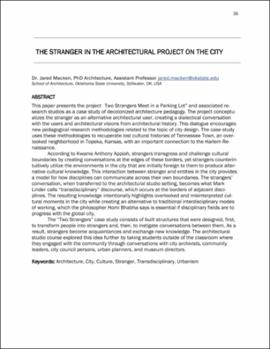| dc.contributor.author | Macken, Jared | |
| dc.date.accessioned | 2022-03-23T20:45:03Z | |
| dc.date.available | 2022-03-23T20:45:03Z | |
| dc.date.issued | 2022 | |
| dc.identifier.citation | Macken, Jared, "The Stranger in the Architectural Project on the City," in Person, Angela M., Anthony Cricchio, and Stephanie Z. Pilat, eds. 2022. Proceedings of Schools of Thought: Rethinking Architectural Pedagogy, Norman, Oklahoma, March 5-7, 2020. University of Oklahoma Libraries: ShareOK. | |
| dc.identifier.uri | https://hdl.handle.net/11244/335078 | |
| dc.description | This paper was presented at the 2020 Schools of Thought Conference hosted by the Christopher C. Gibbs College of Architecture at the University of Oklahoma. | |
| dc.description.abstract | This paper presents the project “Two Strangers Meet in a Parking Lot” and associated research studios as a case study of decolonized architecture pedagogy. The project conceptualizes the stranger as an alternative architectural user, creating a dialectical conversation with the users and architectural visions from architectural history. This dialogue encourages new pedagogical research methodologies related to the topic of city design. The case study uses these methodologies to recuperate lost cultural histories of Tennessee Town, an overlooked neighborhood in Topeka, Kansas, with an important connection to the Harlem Renaissance. According to Kwame Anthony Appiah, strangers transgress and challenge cultural boundaries by creating conversations at the edges of these borders, yet strangers counterintuitively utilize the environments in the city that are initially foreign to them to produce alternative cultural knowledge. This interaction between stranger and entities in the city provides a model for how disciplines can communicate across their own boundaries. The strangers’ conversation, when transferred to the architectural studio setting, becomes what Mark Linder calls “transdisciplinary” discourse, which occurs at the borders of adjacent disciplines. The resulting knowledge intentionally highlights overlooked and misinterpreted cultural moments in the city while creating an alternative to traditional interdisciplinary modes of working, which the philosopher Homi Bhabha says is essential if disciplinary fields are to progress with the global city. The “Two Strangers” case study consists of built structures that were designed, first, to transform people into strangers and, then, to instigate conversations between them. As a result, strangers become acquaintances and exchange new knowledge. The architectural studio course explored this idea further by taking students outside of the classroom where they engaged with the community through conversations with city archivists, community leaders, city council persons, urban planners, and museum directors. | |
| dc.description.sponsorship | Support for the project “Two Strangers Meet in a Parking Lot” was provided by a Rocket Grants project award, a program of the Charlotte Street Foundation and the University of Kansas Spencer Museum of Art. Funding was provided by the Andy Warhol Foundation for the Visual Arts. | |
| dc.language.iso | en_US | |
| dc.relation.ispartof | 2020 Schools of Thought Conference | |
| dc.relation.uri | https://hdl.handle.net/11244/335058 | |
| dc.rights | CC BY-NC-SA | |
| dc.rights.uri | https://creativecommons.org/licenses/by-nc-sa/4.0/ | |
| dc.subject | architecture | |
| dc.subject | city | |
| dc.subject | culture | |
| dc.subject | stranger | |
| dc.subject | transdisciplinary | |
| dc.subject | urbanism | |
| dc.subject | decolonization | |
| dc.subject | architectural education | |
| dc.title | The Stranger in the Architectural Project on the City | |
| dc.type | Article | |
| dc.description.peerreview | Yes | |
| dc.identifier.doi | 10.15763/11244/335078 | |
| ou.group | Christopher C. Gibbs College of Architecture | |


